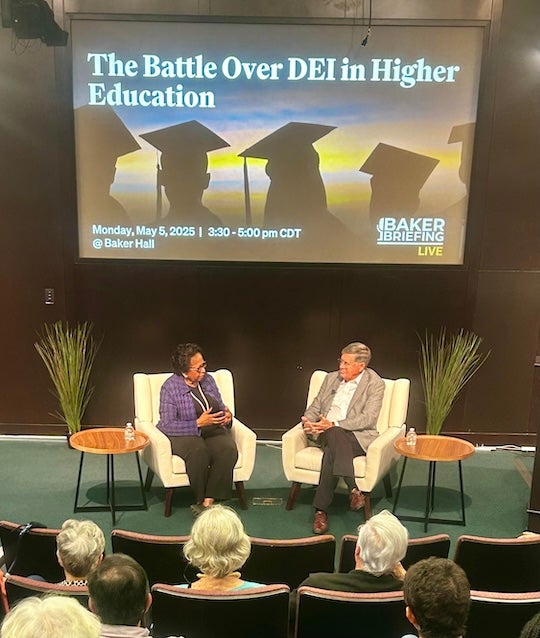David Satterfield, director of Rice University’s Baker Institute for Public Policy, sat down with Ruth Simmons, the President’s Distinguished Fellow and former president of Brown University, Smith College and Prairie View A&M University, for a reflective conversation on the mounting pressures reshaping American higher education. Together, they explored the legal, political and social headwinds facing universities, including how higher education can stay true to its mission of opportunity and inclusion in a climate increasingly hostile to both.
To underscore the stakes, Simmons reflected on her own journey from segregated Texas to Dillard University and later Harvard. She described the stark disparities she encountered and how navigating those worlds shaped her view of what universities can do: “both the harm they can perpetuate and the change they can inspire.”
That experience informed her scholarship and later her leadership, particularly at Brown, where she became the first Black president of an Ivy League school. There, she launched the Slavery and Justice Initiative, a groundbreaking effort to confront Brown’s ties to slavery.

“As our institutions have become more inclusive, they have also become more contested,” Simmons said. “We are witnessing a fierce resistance to change.”
Simmons argues for the measurable benefits of diversity, equity and inclusion (DEI) in faculty hiring and student success as well as its less quantifiable impacts like fostering a sense of belonging. She spoke candidly about impostor syndrome and how many students still struggle to feel they belong in elite academic spaces.
Satterfield noted the paradox of universities being accused of both elitism and overreach, a situation not entirely new for institutions of higher learning, Simmons said.
“Higher education has always been a place where society works out its contradictions,” she said. “Our job is not to please everyone; it’s to lead with integrity.” She insisted that universities cannot avoid controversy when justice is at stake.
They also discussed the difficulty of fostering honest debate while resisting ideological conformity. Simmons drew a clear distinction between open discourse and misinformation: “Universities must be places of open dialogue. However, we must also distinguish between challenging ideas and disinformation.”
Asked if schools can maintain commitments to inclusion even as the acronymn “DEI” becomes politically toxic, Simmons was pragmatic. “We may need to adapt the framing, but we cannot abandon the goals,” she said. “If we believe in equal opportunity, we must continue to fight for it whatever we decide to call it.”
She was especially forceful on the role of leadership: “University presidents and boards must defend the mission of education, even when it puts them at odds with political power.”
When Satterfield asked how universities can restore public trust, Simmons called for transparency, humility and service.
“People want to know that these institutions exist for more than their own prestige,” she said. “We must show that we are solving problems, not just studying them. That we are listening and learning.”

